Does the 10-Year Fishing Ban Compensation Policy in the Yangtze River Basin Improve the Livelihoods of Fishing Households? Evidence from Ma’anshan City, China
Abstract
1. Introduction
2. Literature Review
3. Data and Methodology
3.1. Data and Resources
3.2. Variable Definition and Measurement
3.2.1. Evaluation System of the Livelihood Capital Index
3.2.2. Livelihood Capital Index Measures
3.2.3. Coupling Coordination Degree Measures
3.2.4. Livelihood Capital Mobility Measures
4. Results
4.1. Capital Index of Retired Fishing Households
4.2. Livelihood Capital Coupling Coordination Degree
4.3. Livelihood Capital Mobility
5. Discussion
- (1)
- Optimization and reorganization of human capital, which are reflected in the diversification of household professional skills and health improvement. Traditional fishermen have a single professional skill and are often plagued by rheumatism, schistosomiasis, and other diseases in the long-term. Following retirement, the Ma’anshan government provides reemployment training services and special job fairs for fishermen. The retired fishermen can choose to participate in relevant vocational skills training, and fishing households’ livelihood strategies have changed from single-skilled to diversified skills, which is conducive to improving sustainable livelihood options [43]. In addition, with the change of working environment and the reduction of labor intensity, retired fishermen’s disease risk has been reduced, resulting in superior physical health, which further improves the level of human capital.
- (2)
- Overall improvement in physical capital resulting from housing resettlement projects. Most of the fishermen in Ma’anshan City were traditional workers who live on boats in poor living conditions. During the transition period, the Ma’anshan government provided low rent housing and public rental housing for retired fishermen and supported the acquisition of basic household equipment, aiming to improve retired fishermen’s living environments and provide reliable housing security.
- (3)
- Demand leading of financial capital, which is reflected in the full coverage of social security and increases in loan demand. The survey found that nearly half of the fishermen did not buy medical insurance prior to retiring, and more than 80% of them did not participate in endowment insurance, with weak participant willingness. Following retirement, the Ma’anshan government incorporated all retired fishermen who met the insurance conditions into endowment insurance with three levels of 1500¥, 2000¥, and 3000¥. Specifically, the government pays all fees for those who chose the lowest level, and will pay 1500¥ and 2000¥, respectively for those who chose 2000¥ and 3000¥ levels. Government insurance subsidies have an incentivizing influence on retired fishermen’s willingness to participate. More than half of the fishermen chose to participate at the 2000¥ level or more, and demand for participation in insurance has risen. In addition, the Ma’anshan government also introduced a series of employment subsidy measures and provided entrepreneurship guarantee loans for retired fishermen, which has also stimulated loan demand, consequently improving retired households’ financial capital.
- (4)
- The expansion of social and psychological capital, which is reflected in the community management of retired fishermen. The Ma’anshan government adopted centralized community management for the retired fishermen. The homogeneity of fishermen’s social relations increases the frequency of visits between families and friends, significantly improving social capital. By establishing a helping post station for retired fishermen in the community to provide employment assistance, policy consultation, skills training, and other public services, the relationship between fishermen and government staff has been strengthened, which enhances the sense of belonging among retired fishermen and improves psychological capital [44].
6. Conclusions
- (1)
- The policy’s implementation has significantly raised the livelihood capital of retired fishing households. The growth of human capital is significantly higher than other forms of capital, and the growth of material capital is the lowest. The livelihood capital mode has transformed from social capital dominated to a human–social capital dominant configuration.
- (2)
- The policy’s implementation has optimized retired fishermen’s livelihood capital structure, significantly improving the degree of capital coupling coordination, with a median value increase from 0.451 to 0.663. Overall, the coupling coordination level of household livelihood capital has transitioned from an imbalanced to a coordinated state.
- (3)
- Retired fishing households’ livelihood capital has high mobility, with notable differences among various groups, revealing that most of the low and medium-low livelihood capital groups exhibit upward mobility characteristics, whereas the mobility characteristics of medium and above livelihood capital groups are primarily downward.
Author Contributions
Funding
Institutional Review Board Statement
Data Availability Statement
Conflicts of Interest
References
- Huang, J.; Rozelle, S.; Zhu, X.; Zhao, S.; Sheng, Y. Agricultural and rural development in China during the past four decades: An introduction. Aust. J. Agric. Resour. Econ. 2019, 64, 1–13. [Google Scholar] [CrossRef]
- Huang, W.; Bruemmer, B. Balancing economic revenue and grazing pressure of livestock grazing on the Qinghai-Tibetan-Plateau. Aust. J. Agric. Resour. Econ. 2017, 61, 645–662. [Google Scholar] [CrossRef]
- Liu, J.; Diamond, J. China’s environment in a globalizing world. Nature 2005, 435, 1179–1186. [Google Scholar] [CrossRef] [PubMed]
- Chen, T.; Wang, Y.; Gardner, C.; Wu, F. Threats and protection policies of the aquatic biodiversity in the Yangtze River. J. Nat. Conserv. 2020, 58, 125931. [Google Scholar] [CrossRef]
- Zhang, H.; Kang, M.; Shen, L.; Wu, J.; Li, J.; Du, H.; Wang, C.; Yang, H.; Zhou, Q.; Liu, Z.; et al. Rapid change in Yangtze fisheries and its implications for global freshwater ecosystem management. Fish Fish. 2020, 21, 601–620. [Google Scholar] [CrossRef]
- Razzaq, A.; Tang, Y.; Qing, P. Towards Sustainable Diets: Understanding the Cognitive Mechanism of Consumer Acceptance of Biofortified Foods and the Role of Nutrition Information. Int. J. Environ. Res. Public Health 2021, 18, 1175. [Google Scholar] [CrossRef]
- Qiu, J. Trouble on the Yangtze. Science 2012, 336, 288–291. [Google Scholar] [CrossRef]
- Castello, L.; Macedo, M.N. Large-scale degradation of Amazonian freshwater ecosystems. Glob. Chang. Biol. 2015, 22, 990–1007. [Google Scholar] [CrossRef]
- Ma, T.; Zhou, W.; Chen, L.; Wu, L.; Peter, C.; Dai, G. Concerns about the future of Chinese fisheries based on illegal, unreported and unregulated fishing on the Hanjiang river. Fish. Res. 2018, 199, 212–217. [Google Scholar] [CrossRef]
- Müller, B.; Berg, M.; Yao, Z.P.; Zhang, X.F.; Wang, D.; Pfluger, A. How polluted is the Yangtze river? Water quality downstream from the Three Gorges Dam. Sci. Total Environ. 2008, 402, 232–247. [Google Scholar] [CrossRef]
- Xie, P. Ecological impacts of three gorges dam on lakes Dongting and Poyang. Resour. Environ. Yangtze Basin 2017, 26, 1607–1618, (In Chinese with English Abstract). [Google Scholar] [CrossRef]
- Cheng, L.; Blanchet, S.; Loot, G.; Villéger, S.; Zhang, T.; Lek, S.; Lek-Ang, S.; Li, Z. Temporal changes in the taxonomic and functional diversity of fish communities in shallow Chinese lakes: The effects of river-lake connections and aquaculture. Aquat. Conserv. Mar. Freshw. Ecosyst. 2013, 24, 23–34. [Google Scholar] [CrossRef]
- Zhang, H.; Jarić, I.; Roberts, D.L.; He, Y.; Du, H.; Wu, J.; Wang, C.; Wei, Q. Extinction of one of the world’s largest freshwater fishes: Lessons for conserving the endangered Yangtze fauna. Sci. Total Environ. 2020, 710, 136242. [Google Scholar] [CrossRef] [PubMed]
- Yang, H.; Shen, L.; He, Y.; Tian, H.; Gao, L.; Wu, J.; Mei, Z.; Wei, N.; Wang, L.; Zhu, T.; et al. Status of aquatic organisms resources and their environments in Yangtze river system (2017–2021). J. Fish. China 2022. Available online: https://kns.cnki.net/kcms/detail/31.1283.S.20221009.1234.004.html (accessed on 20 November 2022). (In Chinese with English abstract).
- Elahi, E.; Khalid, Z.; Tauni, M.Z.; Zhang, H.; Lirong, X. Extreme weather events risk to crop-production and the adaptation of innovative management strategies to mitigate the risk: A retrospective survey of rural Punjab, Pakistan. Technovation 2022, 117, 102255. [Google Scholar] [CrossRef]
- Razzaq, A.; Xiao, M.; Zhou, Y.; Liu, H.; Abbas, A.; Liang, W.; Naseer, M.A.U.R. Impact of Participation in Groundwater Market on Farmland, Income, and Water Access: Evidence from Pakistan. Water 2022, 14, 1832. [Google Scholar] [CrossRef]
- Zou, J.; Tang, Y.; Qing, P.; Li, H.; Razzaq, A. Donation or Discount: Effect of Promotion Mode on Green Consumption Behavior. Int. J. Environ. Res. Public Health 2021, 18, 1912. [Google Scholar] [CrossRef]
- Bremer, L.L.; Farley, K.A.; Lopez-Carr, D.; Romero, J. Conservation and livelihood outcomes of payment for ecosystem services in the Ecuadorian Andes: What is the potential for ‘win–win’? Ecosyst. Serv. 2014, 8, 148–165. [Google Scholar] [CrossRef]
- Westman, W.E. How Much Are Nature’s Services Worth? Science 1997, 197, 960–964. [Google Scholar] [CrossRef]
- Costanza, R.; d’Arge, R.; de Groot, R.; Farber, S.; Grasso, M.; Hannon, B.; Limburg, K.; Naeem, S.; O’Neill, R.V.; Paruelo, J.; et al. The value of the world’s ecosystem services and natural capital. Nature 1997, 387, 253–260. [Google Scholar] [CrossRef]
- Jayachandran, S.; de Laat, J.; Lambin, E.F.; Stanton, C.Y.; Audy, R.; Thomas, N.E. Cash for carbon: A randomized trial of payments for ecosystem services to reduce deforestation. Science 2017, 357, 267–273. [Google Scholar] [CrossRef]
- Small, L.-A. The Sustainable Rural Livelihoods Approach: A Critical Review. Can. J. Dev. Stud. 2007, 28, 27–38. [Google Scholar] [CrossRef]
- Scoones, I. Livelihoods perspectives and rural development. J. Peasant. Stud. 2009, 36, 171–196. [Google Scholar] [CrossRef]
- Moyo, C.S.; Francis, J.; Bessong, P.O. Perceptions of community-based field workers on the effect of a longitudinal biomedical research project on their sustainable livelihoods. BMC Public Health 2017, 17, 267. [Google Scholar] [CrossRef] [PubMed]
- Karki, S.T. Do protected areas and conservation incentives contribute to sustainable livelihoods? A case study of Bardia National Park, Nepal. J. Environ. Manag. 2013, 128, 988–999. [Google Scholar] [CrossRef] [PubMed]
- Barnes, C.; Claus, R.; Driessen, P.; Dos Santos, M.J.F.; George, M.A.; Van Laerhoven, F.; Dos Santos, M.F. Uniting forest and livelihood outcomes? Analyzing external actor interventions in sustainable livelihoods in a community forest management context. Int. J. Commons 2017, 11, 532–571. [Google Scholar] [CrossRef]
- Liu, Z.; Chen, Q.; Xie, H. Influence of the Farmer’s Livelihood Assets on Livelihood Strategies in the Western Mountainous Area, China. Sustainability 2018, 10, 875. [Google Scholar] [CrossRef]
- McAfee, K.; Shapiro, E.N. Payments for Ecosystem Services in Mexico: Nature, Neoliberalism, Social Movements, and the State. Ann. Assoc. Am. Geogr. 2010, 100, 579–599. [Google Scholar] [CrossRef]
- Cherni, J.A.; Hill, Y. Energy and policy providing for sustainable rural livelihoods in remote locations—The case of Cuba. Geoforum 2009, 40, 645–654. [Google Scholar] [CrossRef]
- Hu, G.J.; Chen, C.M.; Guo, L.C.; Hou, Y.F. The effects of ecological compensation on livelihood capital and correlation of rural residents in Nature Reserve: Taking Minjiangyuan National Nature Reserve in Fujian as an example. Ecol. Econ. 2018, 34, 6. Available online: https://www.cnki.com.cn/Article/CJFDTOTAL-STJJ201808026.htm (accessed on 21 November 2022). (In Chinese with English abstract).
- Vista, B.M.; Nel, E.; Binns, T. Land, landlords and sustainable livelihoods: The impact of agrarian reform on a coconut hacienda in the Philippines. Land Use Policy 2012, 29, 154–164. [Google Scholar] [CrossRef]
- Kang, X.H.; Shi, J.H.; Zhang, W.J.; Gai, Z.Y. Research on the current situation of the livelihood capital of the herdsman and its factors influencing the background of grazing prohibition subsidy policy in Inner Mongolia. J. Arid. Land Resour. Environ. 2018, 32, 59–65. Available online: https://www.cnki.com.cn/Article/CJFDTOTAL-GHZH201811010.htm (accessed on 23 November 2022). (In Chinese with English Abstract).
- Sims, K.R.E.; Alix-Garcia, J.M. Parks versus PES: Evaluating direct and incentive-based land conservation in Mexico. J. Environ. Econ. Manag. 2017, 86, 8–28. [Google Scholar] [CrossRef]
- Muradian, R.; Corbera, E.; Pascual, U.; Kosoy, N.; May, P.H. Reconciling theory and practice: An alternative conceptual framework for understanding payments for environmental services. Ecol. Econ. 2010, 69, 1202–1208. [Google Scholar] [CrossRef]
- Adhikari, B.; Boag, G. Designing payments for ecosystem services schemes: Some considerations. Curr. Opin. Environ. Sustain. 2013, 5, 72–77. [Google Scholar] [CrossRef]
- Li, D.; Pei, Y.; Chen, H. Is fiscal transfer payment “blood transfusion” or “blood maki-ng”?: An empirical study based on the state-designated poverty-stricken counties. Financ. Trade Econ. 2019, 40, 22–39, (In Chinese with English Abstract). [Google Scholar] [CrossRef]
- Liu, G.G.; Ge, Y.X.; Zhang, H.N. Ecological compensation for poverty alleviation: Synergy, antagonist and docking. Chin. J. Environ. Manag. 2020, 12, 95–101, (In Chinese with English Abstract). [Google Scholar] [CrossRef]
- Su, F.; Xu, Z.M.; Shang, H.Y. An overview of sustainable livelihoods approach. Adv. Earth Sci. 2009, 1, 61–69, (In Chinese with English Abstract). [Google Scholar] [CrossRef]
- Zhao, X.Y.; Jie, Y.Q.; He, X. Livelihood adaptability of farmers in key ecological functional areas under multiple pressures: A case study of Yellow River water source areas of Gannan. China Popul. Resour. Environ. 2020, 30, 140–149, (In Chinese with English Abstract). [Google Scholar] [CrossRef]
- Liu, M.-Y.; Feng, X.-L.; Wang, S.-G.; Zhong, Y. Does poverty-alleviation-based industry development improve farmers’ livelihood capital? J. Integr. Agric. 2021, 20, 915–926. [Google Scholar] [CrossRef]
- Tran, D.D.; Huu, L.H.; Hoang, L.P.; Pham, T.D.; Nguyen, A.H. Sustainability of rice-based livelihoods in the upper floodplains of Vietnamese Mekong Delta: Prospects and challenges. Agric. Water Manag. 2020, 243, 106495. [Google Scholar] [CrossRef]
- Liu, Y.; Xu, Y. A geographic identification of multidimensional poverty in rural China under the framework of sustainable livelihoods analysis. Appl. Geogr. 2016, 73, 62–76. [Google Scholar] [CrossRef]
- Pang, J.; Xu, K.; Jin, L.S. Research on the impact of wetland eco-compensation on farmers’ livelihood strategies and income: An empirical analysis of Poyang Lake. China Land Sci. 2021, 35, 72–80+108, (In Chinese with English Abstract). [Google Scholar] [CrossRef]
- Yu, Y.H. Urban community public service, life satisfaction, and sense of gain. Northwest Popul. J. 2021, 42, 78–90, (In Chinese with English Abstract). [Google Scholar] [CrossRef]
- Sun, T.S.; Hu, X.H. Grassland adaptive management in arid region based on livelihood capitals of peasants and herdsmen-A case study of Fuyun county in the north of Junggar basin, China. J. Nat. Resour. 2018, 33, 761–774, (In Chinese with English Abstract). [Google Scholar] [CrossRef]
- Shi, Y.D.; Li, J.J. The multifunctional development of rural tourism and rural sustainable livelihood: A collaborative study. Tour. Trib. 2018, 33, 15–26, (In Chinese with English Abstract). [Google Scholar] [CrossRef]
- Li, G.P.; Shi, H.Y. The relationship between GTGP and regional economic growth based on Ramsey-Cass-Koopmans modeling. Resour. Sci. 2017, 39, 1712–1724, (In Chinese with English Abstract). [Google Scholar] [CrossRef][Green Version]
- Milder, J.C.; Scherr, S.J.; Bracer, C. Trends and Future Potential of Payment for Ecosystem Services to Alleviate Rural Poverty in Developing Countries. Ecol. Soc. 2010, 15, 4. [Google Scholar] [CrossRef]
- Barro, R.J.; Lee, J.W. A new data set of educational attainment in the world, 1950–2010. J. Dev. Econ. 2013, 104, 184–198. [Google Scholar] [CrossRef]
- Li, J.; Feldman, M.W.; Li, S.; Daily, G.C. Rural household income and inequality under the Sloping Land Conversion Program in western China. Proc. Natl. Acad. Sci. USA 2011, 108, 7721–7726. [Google Scholar] [CrossRef]
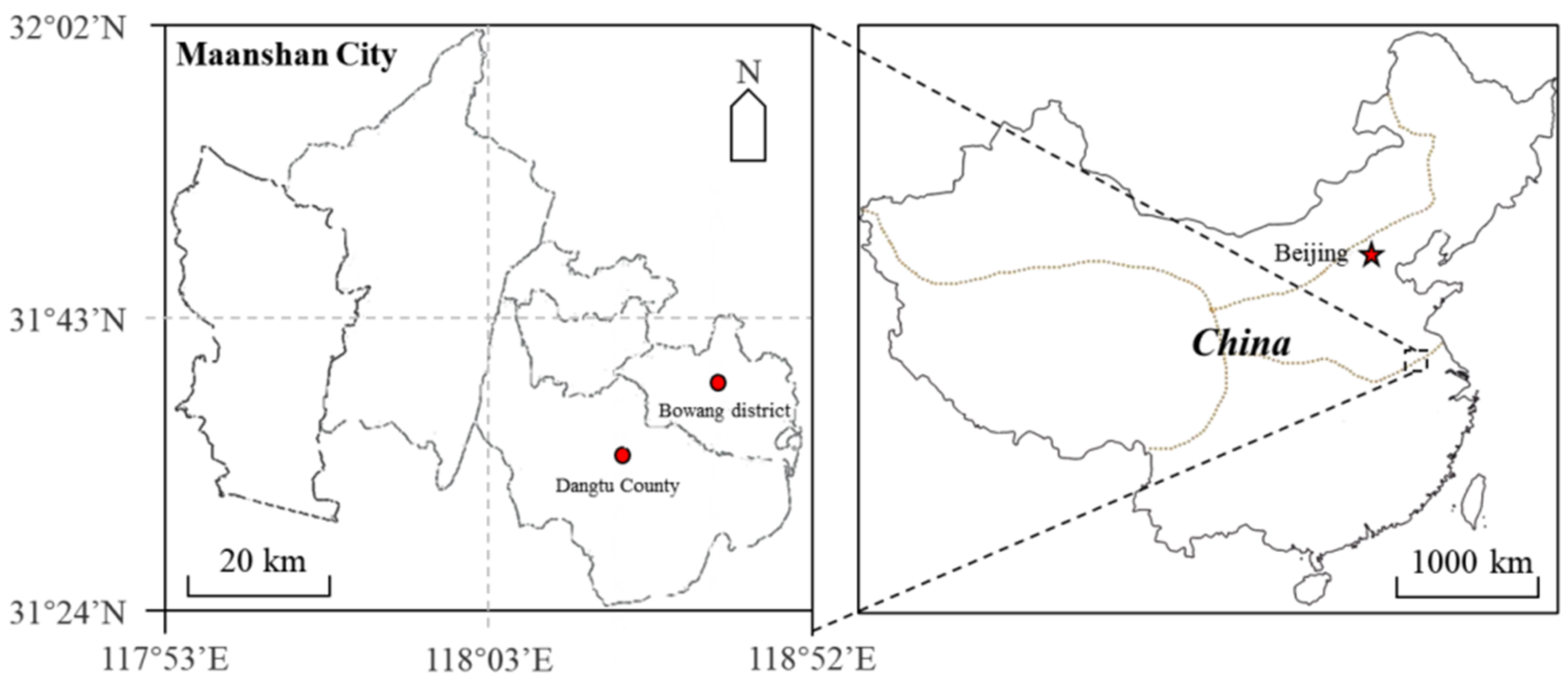
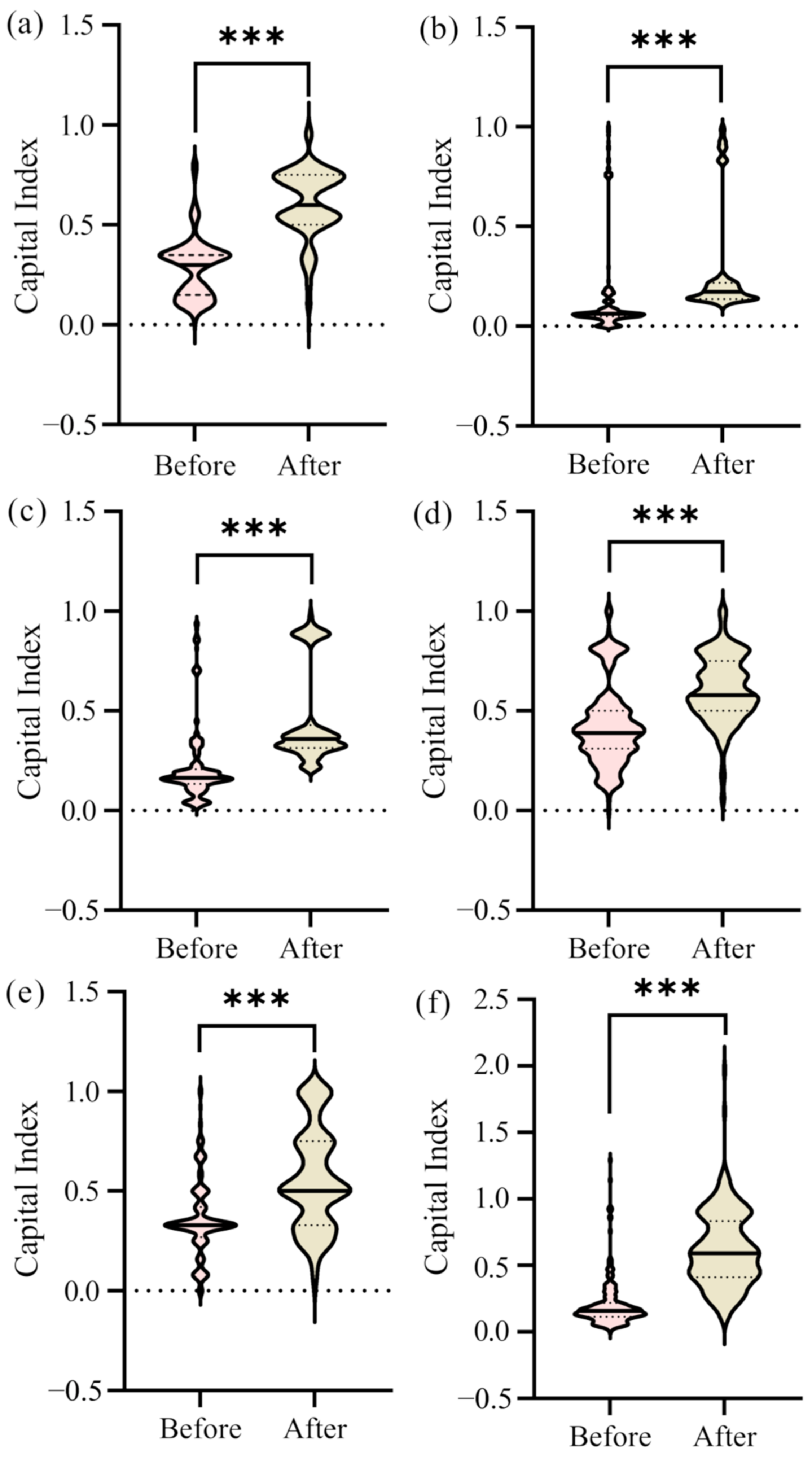
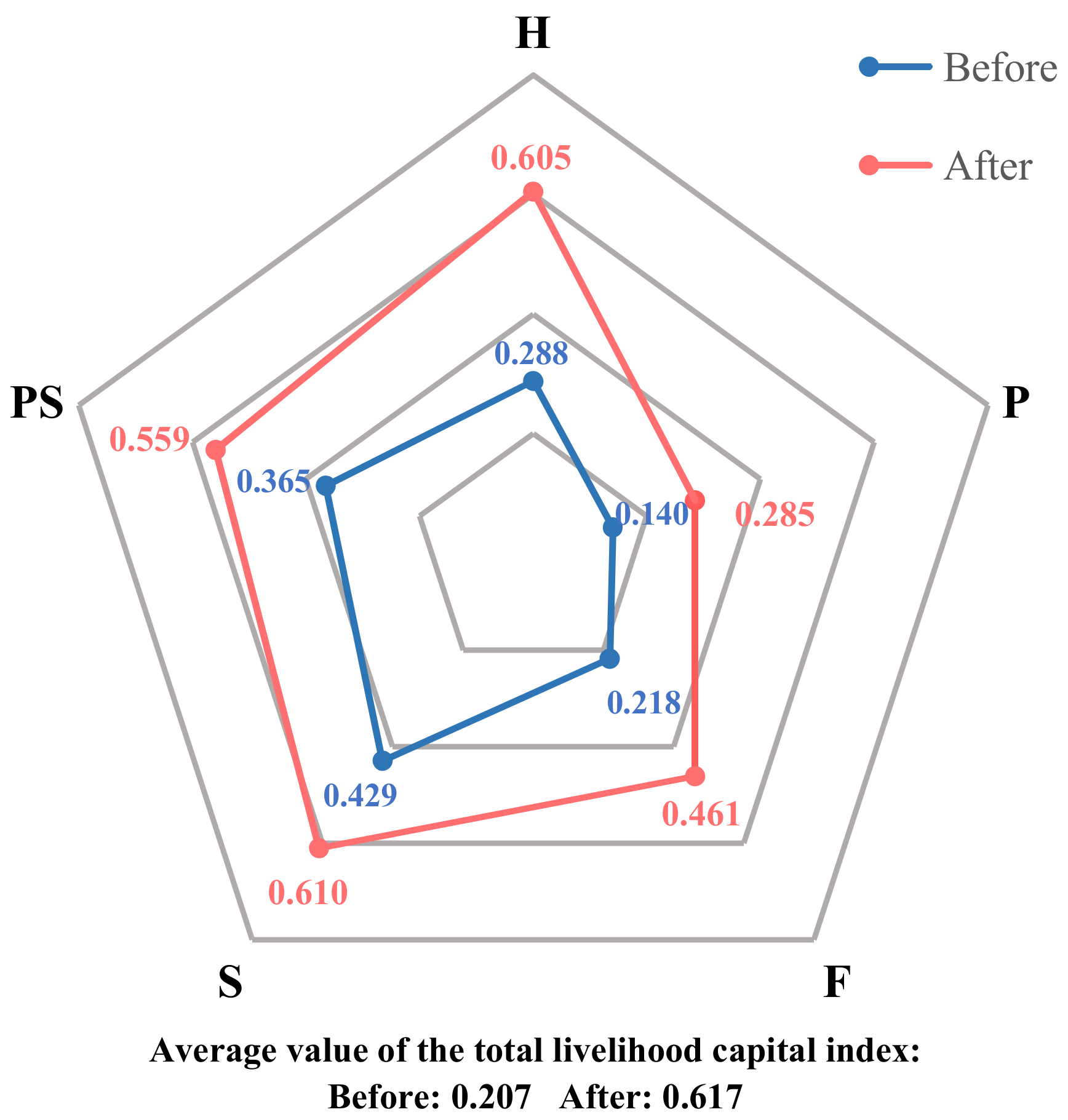
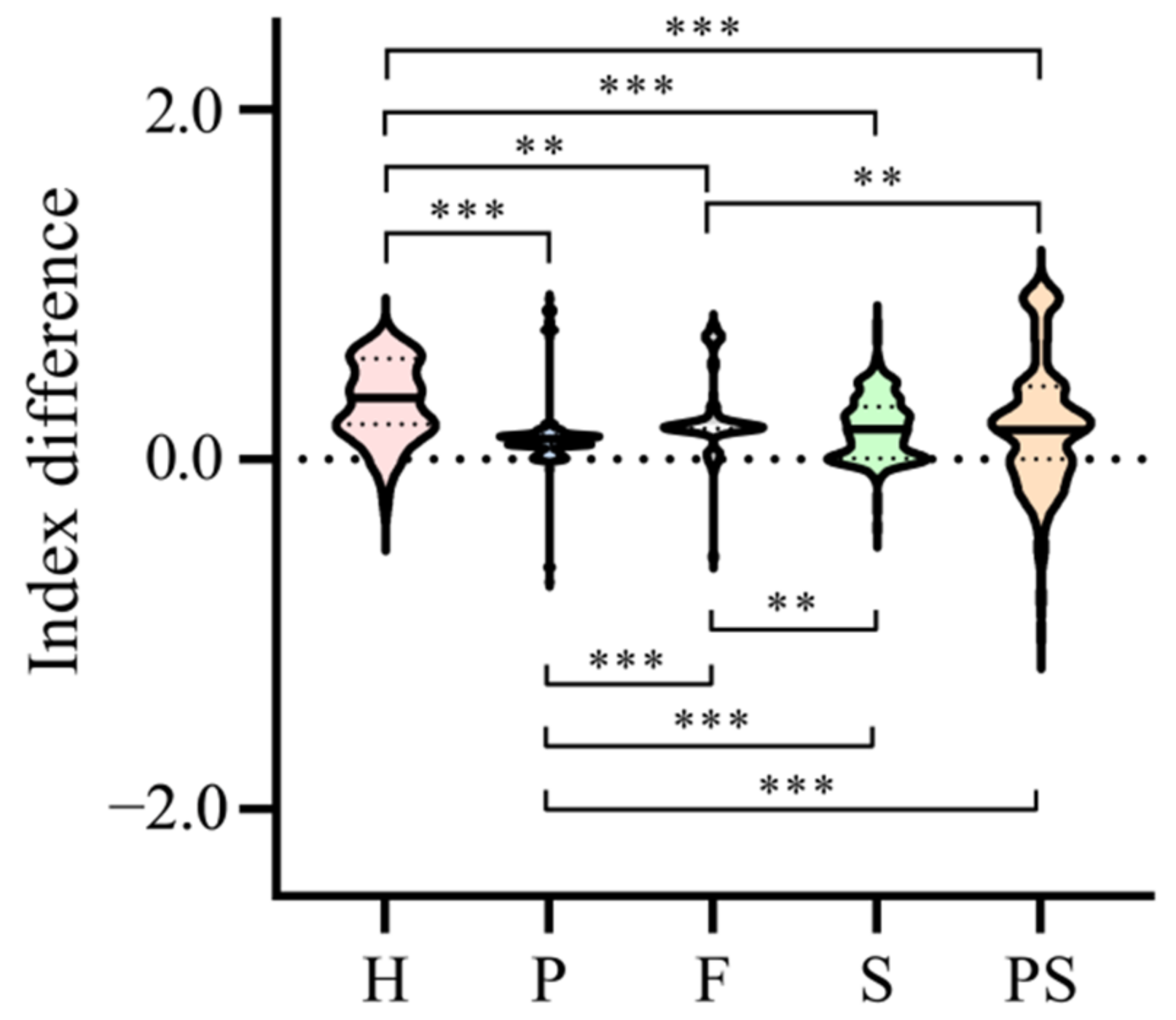
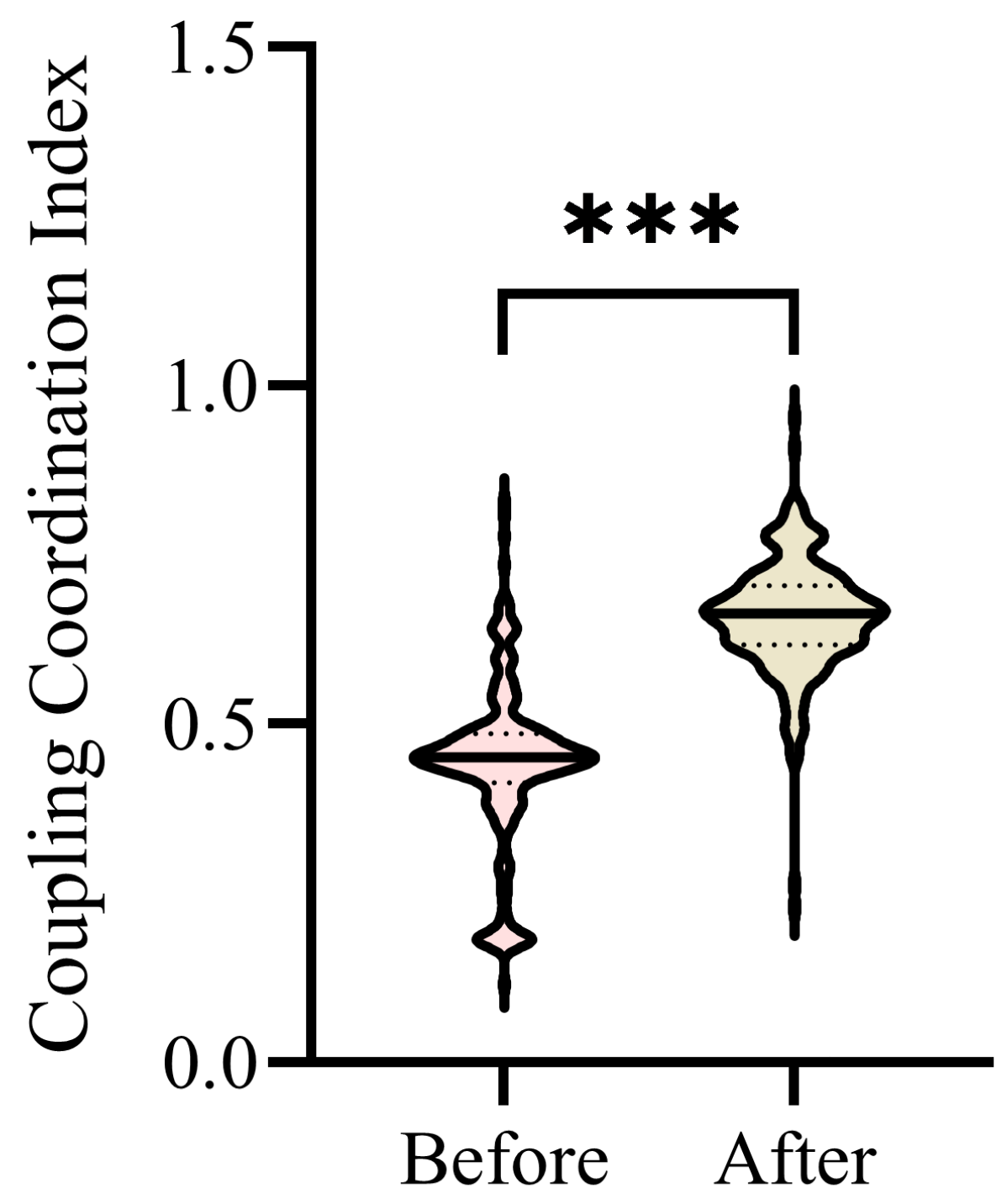
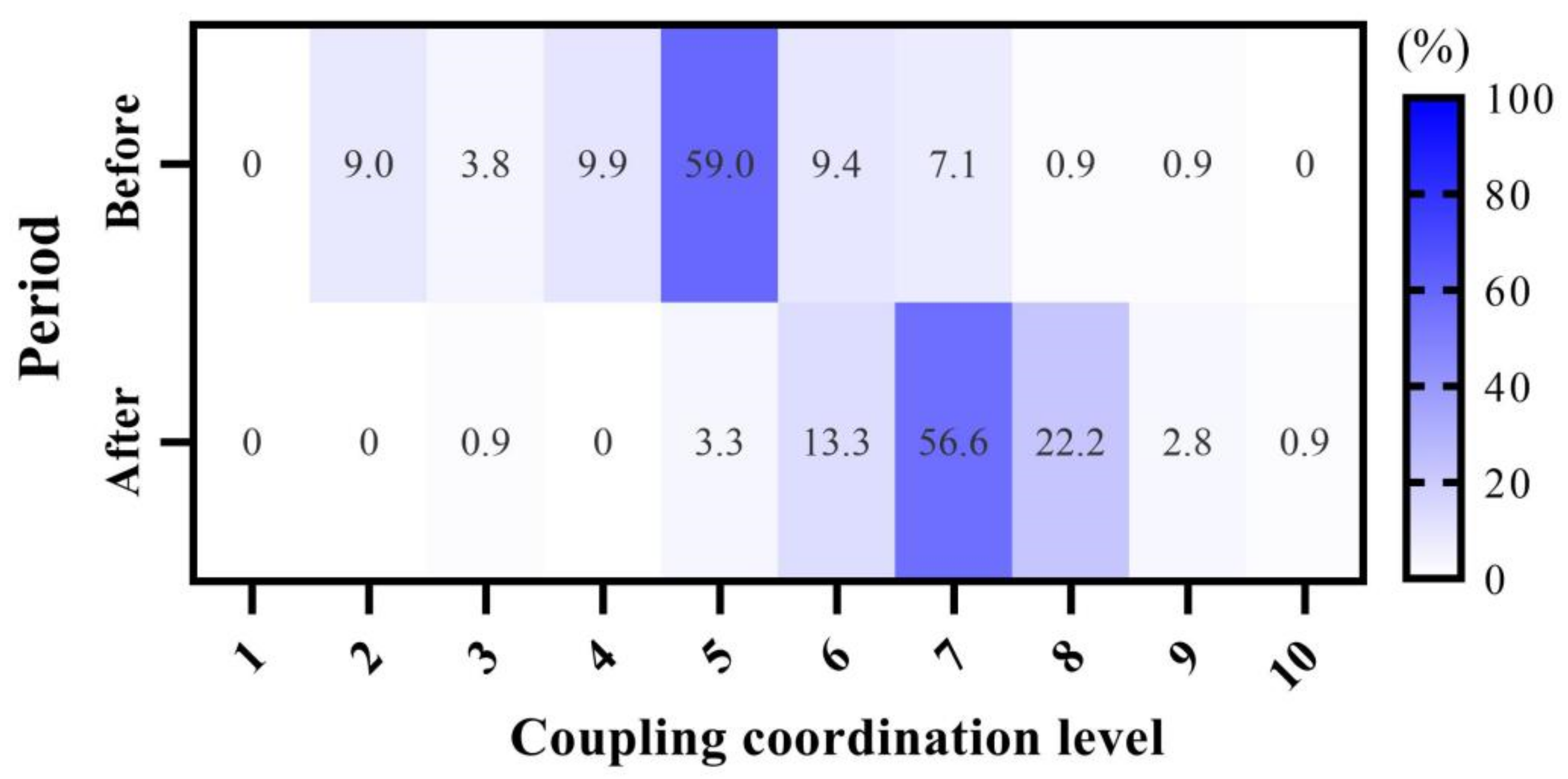

| Capital | Indicator | Indicator Description and Score Assignment | Weight |
|---|---|---|---|
| Human Capital (H) | Health (H1) | Health of fishing couples: Long illness = 1; Frequent illness = 2; Occasional illness = 3; Rarely illness = 4; No illness = 5 | 0.1982 |
| Professional Skills (H2) | Participation of professional skills training: Never = 1; Rarely = 2; Occasionally = 3; Frequent = 4; Always = 5 | 0.8018 | |
| Physical Capital (P) | Residential Area (P1) | Housing construction area (m2) | 0.2101 |
| Durable Consumer Goods (P2) | The number of family durable consumer goods | 0.0868 | |
| Transportation (P3) | Whether the household has a car: Yes = 1, No = 0 | 0.7031 | |
| Financial Capital (F) | Income (F1) | Annual household income after retirement (thousand yuan): F1 < 10(1); 10 ≤ F1 < 30(2); 30 ≤ F1 < 50(3); 50 ≤ F1 < 80(4); F1 ≥ 80(5) | 0.0519 |
| Deposit (F2) | Household Deposit (thousand yuan): F2 < 10(1); 10 ≤ F2 < 50(2); 50 ≤ F2 < 100(3); 100 ≤ F2 < 150(4); F2 ≥ 150(5) | 0.1251 | |
| Medical Insurance (F3) | Whether the household has medical insurance: Yes = 1; No = 0 | 0.0933 | |
| Endowment Insurance (F4) | Whether the household has endowment insurance: Yes = 1; No = 0 | 0.1771 | |
| Loans (F5) | Whether the household has loans: Yes = 1; No = 0 | 0.5525 | |
| Social Capital (S) | Relatives and Friends Closeness (S1) | Visiting relatives and friends: Never = 1; Rarely = 2; Occasionally = 3; Frequent = 4; Always = 5 | 0.2423 |
| Cadres Closeness (S2) | Communicate with cadres: Never = 1; Rarely = 2; Occasionally = 3; Frequent = 4; Always = 5 | 0.3130 | |
| Communities Closeness (S3) | Participation of community activities: Never = 1; Rarely = 2; Occasionally = 3; Frequent = 4; Always = 5 | 0.4447 | |
| Psychological Capital (PS) | Subjective well-being (PS1) | Satisfaction with standard of living: Very dissatisfied = 1; Dissatisfied = 2; General = 3; Satisfied = 4; Very satisfied = 5 | 0.3167 |
| Sense of living crisis (PS2) | Feel anxious about the future: Always = 1; Frequent = 2; Occasionally = 3; Rarely = 4; Never = 5 | 0.6833 |
| Level | Index Interval | Imbalance | Level | Index Interval | Coordination |
|---|---|---|---|---|---|
| 1 | 0.00 < D ≤ 0.09 | Extreme imbalance | 6 | 0.49 < D ≤ 0.59 | Barely coordination |
| 2 | 0.09 < D ≤ 0.19 | Serious imbalance | 7 | 0.59 < D ≤ 0.69 | Primary coordination |
| 3 | 0.19 < D ≤ 0.29 | Moderate imbalance | 8 | 0.69 < D ≤ 0.79 | Moderate coordination |
| 4 | 0.29 < D ≤ 0.39 | Mild imbalance | 9 | 0.79 < D ≤ 0.89 | Well coordination |
| 5 | 0.39 < D ≤ 0.49 | Slightly imbalance | 10 | 0.89 < D ≤ 1.00 | Highly coordination |
| Parameters | Formulas |
|---|---|
| Chi-square index | |
| Inertia ratio | |
| Relative mobility ratio | |
| Average moving position |
| Parameters | Value |
|---|---|
| Chi-square index | 1.305 |
| Inertia ratio | 0.262 |
| Relative mobility ratio | 0.826 |
| Average moving position | 1.852 |
Publisher’s Note: MDPI stays neutral with regard to jurisdictional claims in published maps and institutional affiliations. |
© 2022 by the authors. Licensee MDPI, Basel, Switzerland. This article is an open access article distributed under the terms and conditions of the Creative Commons Attribution (CC BY) license (https://creativecommons.org/licenses/by/4.0/).
Share and Cite
He, Y.; Chen, T. Does the 10-Year Fishing Ban Compensation Policy in the Yangtze River Basin Improve the Livelihoods of Fishing Households? Evidence from Ma’anshan City, China. Agriculture 2022, 12, 2088. https://doi.org/10.3390/agriculture12122088
He Y, Chen T. Does the 10-Year Fishing Ban Compensation Policy in the Yangtze River Basin Improve the Livelihoods of Fishing Households? Evidence from Ma’anshan City, China. Agriculture. 2022; 12(12):2088. https://doi.org/10.3390/agriculture12122088
Chicago/Turabian StyleHe, Yufeng, and Tinggui Chen. 2022. "Does the 10-Year Fishing Ban Compensation Policy in the Yangtze River Basin Improve the Livelihoods of Fishing Households? Evidence from Ma’anshan City, China" Agriculture 12, no. 12: 2088. https://doi.org/10.3390/agriculture12122088
APA StyleHe, Y., & Chen, T. (2022). Does the 10-Year Fishing Ban Compensation Policy in the Yangtze River Basin Improve the Livelihoods of Fishing Households? Evidence from Ma’anshan City, China. Agriculture, 12(12), 2088. https://doi.org/10.3390/agriculture12122088






